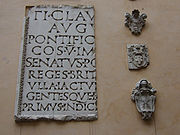
Arch of Claudius (British victory)
Encyclopedia

- See also Arches of ClaudiusArches of Claudius-Aqua Virgo:One of the arches of the Aqua Virgo, which spanned an ancient street, and was restored in monumental form by Claudius . This arch is still standing, in the court of No. 14 Via del Nazareno , and is probably referred to by Martial IV.18...
for arches to him in other locations in Rome and the Empire.
The Arch of Claudius was a triumphal arch in honour of the emperor Claudius
Claudius
Claudius , was Roman Emperor from 41 to 54. A member of the Julio-Claudian dynasty, he was the son of Drusus and Antonia Minor. He was born at Lugdunum in Gaul and was the first Roman Emperor to be born outside Italy...
's successful invasion of Britain
Roman conquest of Britain
The Roman conquest of Britain was a gradual process, beginning effectively in AD 43 under Emperor Claudius, whose general Aulus Plautius served as first governor of Britannia. Great Britain had already frequently been the target of invasions, planned and actual, by forces of the Roman Republic and...
. It is now lost, though its inscription is held at the Capitoline Museums
Capitoline Museums
The Capitoline Museums are a group of art and archeological museums in Piazza del Campidoglio, on top of the Capitoline Hill in Rome, Italy. The museums are contained in three palazzi surrounding a central trapezoidal piazza in a plan conceived by Michelangelo Buonarroti in 1536 and executed over...
and may be seen here.
The arch was dedicated in AD 51, although it was anticipated on the reverse of coins issued in AD 46-47 and AD 49. The coin shows it as surmounted by an equestrian statue between two trophies
Tropaeum
Tropaeum is an extinct genus of ammonite cephalopod found throughout the oceans of the world during the Early Cretaceous. As with many other members of the family Ancyloceratidae, there was a trend among species within this genus to uncoil somewhat, in a very similar manner in the genus...
. It was a conversion of one of the arches of the Aqua Virgo
Aqua Virgo
The Aqua Virgo was one of the 11 aqueducts that supplied the city of ancient Rome. The aqueduct fell into disuse with the fall of the Roman Empire, but was fully restored nearly a whole millennium later during the Renaissance to take its current form as the Acqua Vergine.The Aqua Virgo was...
aqueduct where it crossed the Via Flaminia, the main road to the north, just north of the Saepta.
The reconstructed inscription (also found on arches dedicated for the same reason at Boulogne-sur-Mer
Boulogne-sur-Mer
-Road:* Metropolitan bus services are operated by the TCRB* Coach services to Calais and Dunkerque* A16 motorway-Rail:* The main railway station is Gare de Boulogne-Ville and located in the south of the city....
- Claudius's departure point for Britain - and at Cyzicus
Cyzicus
Cyzicus was an ancient town of Mysia in Anatolia in the current Balıkesir Province of Turkey. It was located on the shoreward side of the present Kapıdağ Peninsula , a tombolo which is said to have originally been an island in the Sea of Marmara only to be connected to the mainland in historic...
) reads:
It seems to have been in ruins as early as the eighth century, but in 1562, in 1641, and again in 1869 portions of the structure were found, including part of the principal inscription, inscriptions dedicated to other members of the imperial family, some of the foundations, and fragments of sculpture of which all traces have been lost.
Primary
Secondary - coins
- The Monuments of Ancient Rome as Coin Types (1989) by Philip V. Hill
- Freeman & Sear Catalog No.12 (2005), item 536.
- BM Claud. 29, 32‑35, 49‑50
- Cohen, Claudius 16‑24
- HJ 468‑9; LS III.125‑6
- PBS III.220‑223
Secondary - other
- For reliefs discovered in the 1920s which may belong to it, see NS 1925, 230‑233; Bocconi, Musei Capitolini, 292.9; 294.14; YW 1925‑6, 112.
External links
- James Grout: Arch of Claudius, part of the Encyclopædia Romana

